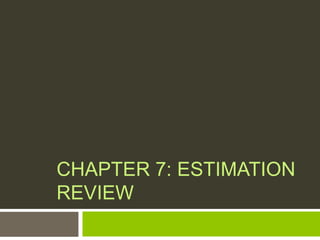
Chapter 7 review
- 2. Estimation
- 5. Page 338 Confidence Interval for μ when σ is Known
- 6. How To Construct a Confidence Interval for μ when σ is Known
- 7. Confidence Interval for μ when σ is Unknown Page 350 Requirements Let x be a random variable appropriate to your application. Obtain a simple random sample (of size n) of x values from which you compute the sample mean and the sample standard deviation s. If you can assume that x has a normal distribution or is mound- shaped, then any sample size n will work. If you cannot assume this, then use a sample size of n ≥ 30. Confidence Interval for μ when σ is unknown where = sample mean of a simple random sample = confidence level (0 < c < 1) = critical value d.f. = n – 1
- 8. How To Construct a Confidence Interval 1. Check Requirements Simple random sample? Assumption of normality? Sample size? Sample mean? Sample standard deviation s? 2. Compute E 3. Construct the interval using
- 9.
- 10.
- 11. Confidence Intervals for the difference between two population parameters There are several types of confidence intervals for the difference between two population parameters Confidence Intervals for 1 – 2 (1 and 2 known) Confidence Intervals for 1 – 2 (1 and 2 Are Unknown) Confidence Intervals for 1 – 2 (1 = 2) Confidence Intervals for p1 – p2
- 12. How to Interpret Confidence Intervals for Differences
- 13. Confidence Intervals for 1 – 2 (1 and 2 known)
- 14. Confidence Intervals for 1 – 2 (1 and 2 known)
- 15. How to construct the confidence interval for 1 – 2 (1 and 2 known)
- 16. Confidence Intervals for 1 – 2 (1 and 2 Are Unknown)
- 17. Confidence Intervals for 1 – 2 (1 and 2 Are Unknown)
- 18. How to construct the confidence interval for 1 – 2 (1 and 2 unknown)
- 19. Estimating the Difference of Proportions p1 – p2 Requirements Consider two independent binomial experiments
- 20. Estimating the Difference of Proportions p1 – p2
- 21. How to construct the confidence interval for p1 – p2
- 22. Page 342 How to Find the Sample Size n for Estimating μ when is σ known
- 23. Page 366